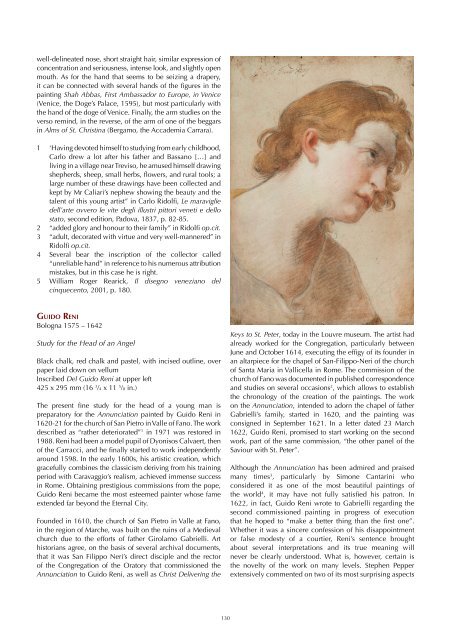Create successful ePaper yourself
Turn your PDF publications into a flip-book with our unique Google optimized e-Paper software.
well-<strong>de</strong>lineated nose, short straight hair, similar expression of<br />
concentration <strong>and</strong> seriousness, intense look, <strong>and</strong> slightly open<br />
mouth. As for the h<strong>and</strong> that seems to be seizing a drapery,<br />
it can be connected with several h<strong>and</strong>s of the figures in the<br />
painting Shah Abbas, First Ambassador to Europe, in Venice<br />
(Venice, the Doge’s Palace, 1595), but most particularly with<br />
the h<strong>and</strong> of the doge of Venice. Finally, the arm studies on the<br />
verso remind, in the reverse, of the arm of one of the beggars<br />
in Alms of St. Christina (Bergamo, the Acca<strong>de</strong>mia Carrara).<br />
1 ‘Having <strong>de</strong>voted himself to studying from early childhood,<br />
Carlo drew a lot after his father <strong>and</strong> Bassano […] <strong>and</strong><br />
living in a village near Treviso, he amused himself drawing<br />
shepherds, sheep, small herbs, flowers, <strong>and</strong> rural tools; a<br />
large number of these drawings have been collected <strong>and</strong><br />
kept by Mr Caliari’s nephew showing the beauty <strong>and</strong> the<br />
talent of this young artist” in Carlo Ridolfi, Le maraviglie<br />
<strong>de</strong>ll’arte ovvero le vite <strong>de</strong>gli illustri pittori veneti e <strong>de</strong>llo<br />
stato, second edition, Padova, 1837, p. 82-85.<br />
2 “ad<strong>de</strong>d glory <strong>and</strong> honour to their family” in Ridolfi op.cit.<br />
3 “adult, <strong>de</strong>corated with virtue <strong>and</strong> very well-mannered” in<br />
Ridolfi op.cit.<br />
4 Several bear the inscription of the collector called<br />
“unreliable h<strong>and</strong>” in reference to his numerous attribution<br />
mistakes, but in this case he is right.<br />
5 William Roger Rearick, Il disegno veneziano <strong>de</strong>l<br />
cinquecento, 2001, p. 180.<br />
Guido Reni<br />
Bologna 1575 – 1642<br />
Study for the Head of an Angel<br />
Black chalk, red chalk <strong>and</strong> pastel, with incised outline, over<br />
paper laid down on vellum<br />
Inscribed Del Guido Reni at upper left<br />
425 x 295 mm (16 3 /4 x 11 5 /8 in.)<br />
The present fine study for the head of a young man is<br />
preparatory for the Annunciation painted by Guido Reni in<br />
1620-21 for the church of San Pietro in Valle of Fano. The work<br />
<strong>de</strong>scribed as “rather <strong>de</strong>teriorated” 1 in 1971 was restored in<br />
1988. Reni had been a mo<strong>de</strong>l pupil of Dyonisos Calvaert, then<br />
of the Carracci, <strong>and</strong> he finally started to work in<strong>de</strong>pen<strong>de</strong>ntly<br />
around 1598. In the early 1600s, his artistic creation, which<br />
gracefully combines the classicism <strong>de</strong>riving from his training<br />
period with Caravaggio’s realism, achieved immense success<br />
in Rome. Obtaining prestigious commissions from the pope,<br />
Guido Reni became the most esteemed painter whose fame<br />
exten<strong>de</strong>d far beyond the Eternal City.<br />
Foun<strong>de</strong>d in 1610, the church of San Pietro in Valle at Fano,<br />
in the region of Marche, was built on the ruins of a Medieval<br />
church due to the efforts of father Girolamo Gabrielli. Art<br />
historians agree, on the basis of several archival documents,<br />
that it was San Filippo Neri’s direct disciple <strong>and</strong> the rector<br />
of the Congregation of the Oratory that commissioned the<br />
Annunciation to Guido Reni, as well as Christ Delivering the<br />
Keys to St. Peter, today in the Louvre museum. The artist had<br />
already worked for the Congregation, particularly between<br />
June <strong>and</strong> October 1614, executing the effigy of its foun<strong>de</strong>r in<br />
an altarpiece for the chapel of San-Filippo-Neri of the church<br />
of Santa Maria in Vallicella in Rome. The commission of the<br />
church of Fano was documented in published correspon<strong>de</strong>nce<br />
<strong>and</strong> studies on several occasions 2 , which allows to establish<br />
the chronology of the creation of the paintings. The work<br />
on the Annunciation, inten<strong>de</strong>d to adorn the chapel of father<br />
Gabrielli’s family, started in 1620, <strong>and</strong> the painting was<br />
consigned in September 1621. In a letter dated 23 March<br />
1622, Guido Reni, promised to start working on the second<br />
work, part of the same commission, “the other panel of the<br />
Saviour with St. Peter”.<br />
Although the Annunciation has been admired <strong>and</strong> praised<br />
many times 3 , particularly by Simone Cantarini who<br />
consi<strong>de</strong>red it as one of the most beautiful paintings of<br />
the world 4 , it may have not fully satisfied his patron. In<br />
1622, in fact, Guido Reni wrote to Gabrielli regarding the<br />
second commissioned painting in progress of execution<br />
that he hoped to “make a better thing than the first one”.<br />
Whether it was a sincere confession of his disappointment<br />
or false mo<strong>de</strong>sty of a courtier, Reni’s sentence brought<br />
about several interpretations <strong>and</strong> its true meaning will<br />
never be clearly un<strong>de</strong>rstood. What is, however, certain is<br />
the novelty of the work on many levels. Stephen Pepper<br />
extensively commented on two of its most surprising aspects<br />
130
















